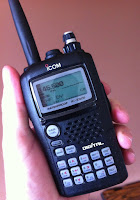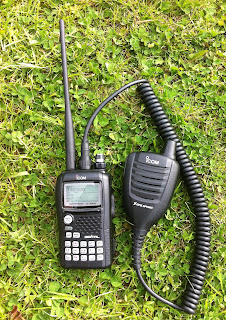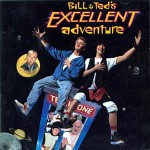Archive for the ‘icom’ Category
 Icom launches a new handy
Icom launches a new handy
 |
| Icom ID-51 |
Icom has demonstrated a prototype of its latest dual-band handheld transceiver – the ID-51A. (The European version will be the ID-51E.)
Covering 2m and 70cm, the ID-51 can also receive FM broadcasts and AM short wave radio. It supports D-Star (of course) as well as FM mode, and boasts a large 128×104 pixels display, the largest yet seen on an amateur radio handheld rig.
Like its smaller sibling the UHF-only ID-31, the ID-51A/E has a built-in GPS which can be used for track logging to a micro-SD card. The storage card can also be used to record incoming and outgoing voice traffic. Very useful – not!
Disappointingly though not unexpectedly, this new Icom does not support APRS, though it presumably supports D-Star’s rather lame version, D-PRS.
The ID-51 is being billed as the most technically advanced handheld, though it looks like you will be paying a lot for features – like the GPS and short wave receiver – for which most hams will have little use. I doubt that the large display – never mind the GPS – will do much to extend battery life, though Icom will offer an extended battery pack (at the usual inflated Icom prices no doubt.) However it is nice to see a manufacturer breaking the mould for HT user interfaces which have changed little for the last 20 years.
 Solar Power for QRP
Solar Power for QRP
- 3.37 Amps in the Sun
- Brace Detail
- Close Up of Curved Leg End
- Close Up of Leg Braces
- Close Up of Leg Braces 2
- Close up of Solar panel controller
- Corner Detail of Leg Attachment
- Corner Detail of Leg Attachment For Other Leg
- Curved Leg Section Cut Away to Allow Legs to Swing Out, Avoiding Panel Damage
- Drilling to Set Legs in Place
- Go Box on the Left, 100 Watt 5 Amp Solar Panel on the Right
- Legs Attached to the Solar Panel Allows it to be Self Standing
- Legs Fold Into the Solar Panel Frame for Easy Storage
- Rear of Solar Panel, Controler is mounted with Velcro
- Right Leg Attached to Panel Frame
- Solar Panel Stored in its shipping case.
I’ve always wanted to operate my radio on Solar Power. This was a fun to do project. I can’t wait to bring it to a Field Day Event.
I bought the aluminum from Metals Depot in Kentucky. (link attached) They have lots of aluminum shapes and parts to choose from. The parts arrived via UPS. It nice to have a good source like this for ham radio projects.http://www.metalsdepot.com/
HQRP is a good company to buy solar panel parts and controlers from. The QRP part of their name is just coincidental to this being a QRP project. http://hqrp.com/
de AA1IK
Ernest Gregoire
72
 Icom IC-E92D – Why This Is My ‘Staple’ Handheld
Icom IC-E92D – Why This Is My ‘Staple’ Handheld
 |
| Icom IC-E92D |
 |
| Built for the outdoor life - with HM-175 GPS Speaker-Mic |
| SMA - SO239 adaptor |
 AmateurLogic.TV 33: One Jam Packed Show
AmateurLogic.TV 33: One Jam Packed Show
George visits the Twit.tv studios and interviews Randy Hall, K7AGE. Tommy visits the Huntsville Hamfest. Jim builds an Audio Isolation Interface. Peter shows us the DATV QSO Party.
 LHS Episode #052: Amateur Fantasies
LHS Episode #052: Amateur Fantasies
 Hello, podcast listeners! It has been an extra week that you've had to wait for our landmark episode 50 to be released. I (Russ) had planned to do an episode from his hotel room in San Jose. Unfortunately, the network there was so bad it was impossible to record so everything was pushed back.
Hello, podcast listeners! It has been an extra week that you've had to wait for our landmark episode 50 to be released. I (Russ) had planned to do an episode from his hotel room in San Jose. Unfortunately, the network there was so bad it was impossible to record so everything was pushed back.
In this episode, we talk about life, love and amateur radio. OK, not really. But we touch on a number of interesting topics including the necessity of logging in amateur radio, theoretical nonsense like Internet via Moonbounce and, thanks to a couple of missives from AD7MI, we wax philosophical on our ideal ham shacks--computers running Linux included of course.
Thank you for being a listener of our show. If you're new: Welcome! Please tell everyone you know where they can find us. And keep fighting the good fight.
73 de The LHS Guys
 LHS Episode #033: Bill and Ted’s Excellent Episode
LHS Episode #033: Bill and Ted’s Excellent Episode
 Episode #031 of Linux in the HAM Shack is now available, and nearly on time. Due to myriad circumstances in our lives, we had to put off recording of this episode until February 9th. It is therefore almost astonishing that I can announced that it is being released on February 10th. After this, everything should return to its normal bi-weekly cycle.
Episode #031 of Linux in the HAM Shack is now available, and nearly on time. Due to myriad circumstances in our lives, we had to put off recording of this episode until February 9th. It is therefore almost astonishing that I can announced that it is being released on February 10th. After this, everything should return to its normal bi-weekly cycle.
I would very much like to thank Bill, KA9WKA, Ted, WA0EIR and Andy (Integgroll on IRC) for filling in as co-hosts for Richard on this episode. Sadly I must report that Richard lost his mother to a battle with cancer yesterday morning. I know the thoughts, prayers and deepest sympathies of myself and our listeners are with Richard and his family during this time. Unfortunately, I do not have any further details on events in Balch Springs at this time. If you would like to send your condolences, please address them to [email protected]. Richard may feel like joining me to record again in a week's time, but if his circumstances do not permit, we will certainly carry on and offer him all of the time and space he may need to recover.
In this episode, our esteemed round table guests touch on a variety of topics. In usual fashion, I address feedback at the start. Beyond that, topics range from MicroHam digital rig interfaces, a rant about Yaesu, Linux Mint 8, cloud storage, e-readers and much, much more. Thank you for your faithful listenership.
73 de Russ
 LHS Episode #024: Darth Hideous
LHS Episode #024: Darth Hideous
In this latest installment of Linux in the HAM Shack, we air the second half of our interview with Bill, KA9WKA, from Episode #022. While the first part of the interview focused on Linux Mint and EeePC netbooks, this part is mostly about amateur radio, answering questions from the chat room and generally having a good time. In fact, it’s like a good old fashioned ragchew.
Not ones to leave out actual content and learning, we address questions from listener feedback, and Richard talks about using rig control software under WINE for Icom, Yaesu and Kenwood radios. And of course there are other topics thrown into the mix as well. Thank you to all of our listeners, old and new, for downloading this latest episode. Please tell all your friends about us and send us feedback, whether by e-mail, forum or voice mail. Hope to see everyone in Belton, TX on October 3rd or in Columbus, OH from September 25-27.
And may the force be with you.




























